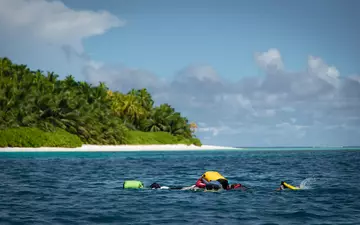
Jack Sheehy
Blue Finance Specialist
Meet Jack Sheehy!
Jack is our Blue Finance Specialist, managing our marine projects as part of the Sustainable Business and Finance team. Before we dive deeper into the world of blue carbon, let’s get to know a little bit about Jack.
Jack’s journey into the world of blue carbon and sustainable finance was not a straightforward path. After completing his BSc in Marine Biology and Coastal Ecology from the University of Plymouth, he worked a variety of different roles, but mostly in the dive industry as a dive instructor, videographer and cave diver. This career took him to Orkney, Scotland, where he had the opportunity to return to university and do something that was potentially more impactful. This led him to complete his MSc in Marine Renewable Energy, setting the stage for his future endeavours.
He then worked as a consultant and embarked on his doctoral studies in Blue Carbon; Jack also got a chance to intern with the Joint Nature Conservation Committee (JNCC) and do some cetacean research based on their potential for climate change mitigation. Jack’s PhD led him directly into sustainable finance, eco-social economics, and his role at ZSL.
Jack’s role as a Blue Finance Specialist involves managing or providing technical inputs to various projects, including:
- Rat eradication and native habitat restoration in Chagos.
- Seagrass restoration in India.
- Mangrove restoration and conservation in Mozambique.
- Mangrove restoration and conservation in the Philippines.
- Urban river restoration along the Thames estuary.
These projects focus on sustainable finance to support ecological conservation, investor engagement, and societal well-being. To understand what all that means, it might help to first explore some of the terminology used in this area.
Blue Carbon
There is some debate on the definition of blue carbon, but the most general one is that blue carbon is the carbon stored in marine, estuarine, and intertidal systems. There are significant stocks and future storage potential in seagrass, saltmarsh, and mangrove habitats. Coincidentally, these habitats are also at risk from climate change, coastal development, pollutants and plastic. There is therefore potential to protect and restore degraded ‘blue carbon’ habitats, increase their carbon stocks, and thereby mitigate climate change by moving carbon from the atmosphere into the marine habitats and sediments. This is called a ‘Nature-Based Solution’ to climate change mitigation, as it uses natural ecology to support our aims of ‘Carbon Dioxide Removal’ from the atmosphere.
Blue Finance
If we can protect and restore blue carbon habitats through intervention, that intervention project will need finance to support its implementation. This finance can be generated from mechanisms linked to wider policy goals of climate change mitigation (Paris Agreement) and biodiversity restoration (Convention on Biological Diversity or CBD).
To focus on carbon credits, as they’re a little more established than biodiversity credits, carbon values are tied to the estimated damages from climate change impacts if this carbon is released into the atmosphere. We can then use those values of carbon to support the finance of those ecological conservation and restoration projects. This finance is required to fund the project restoration or conservation action, attract investors that want to invest their money in good causes, and perhaps most importantly support community engagement and ownership of the seagrass bed. This supports ‘bottom-up’ project engagement which is essential to long-term project outcomes.
Alternatively, blue carbon projects may also be included in Nationally Determined Contributions for the Paris Agreement. In this case, the country’s government may provide funding to support the project.
Sustainable Finance
Where we have a blue finance project, or other conservation project, we want to ensure that the project integrates ecologic, economic, and societal interests – eco-social economics. This is essential to ensuring that the project is financially viable, able to support itself without additional financial support, and is structured with project permanence or longevity in mind; this normally ranges from 40 to 100 years. The project must therefore engage local communities and stakeholders to deliver ecological targets and subsequently prove project viability for investor engagement. This engagement, and structuring of the project, underpins the sustainable finance needed to support further investment and expansion in sustainable projects and activities.

And so that’s about it! As the Blue Finance Specialist, Jack inputs scientific, technical, and financial expertise to support marine conservation and restoration projects. This can include carbon stock data analysis, spatial mapping, revenue modelling, and stakeholder engagement. In this way, Jack helps support ZSL in leading marine conservation, and global climate change mitigation, adaptation, and biodiversity restoration goals.
Any further questions, please don’t hesitate to get in touch!
Explore our Sustainable Business and Finance endeavours here.
